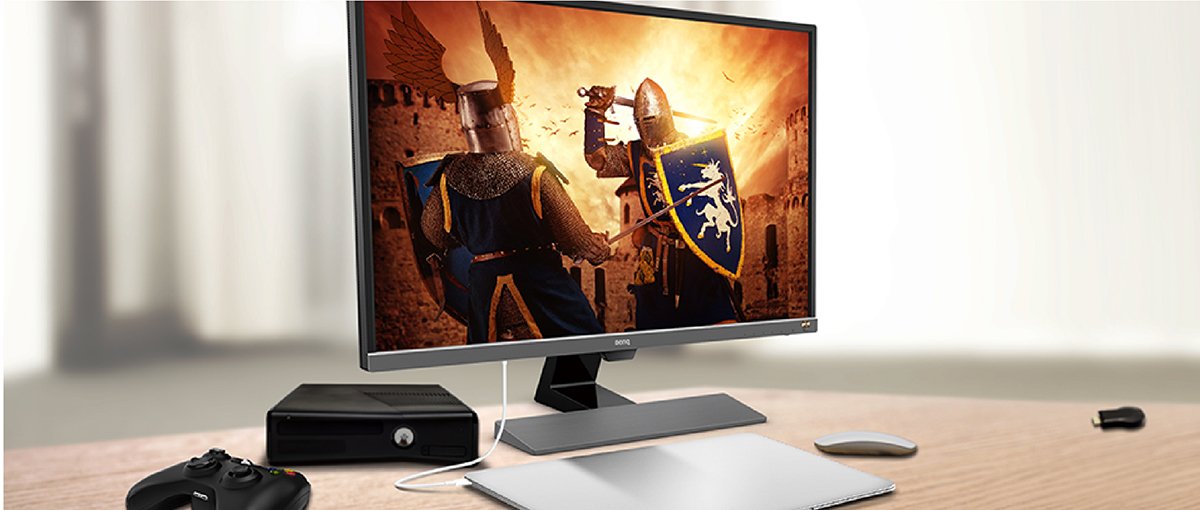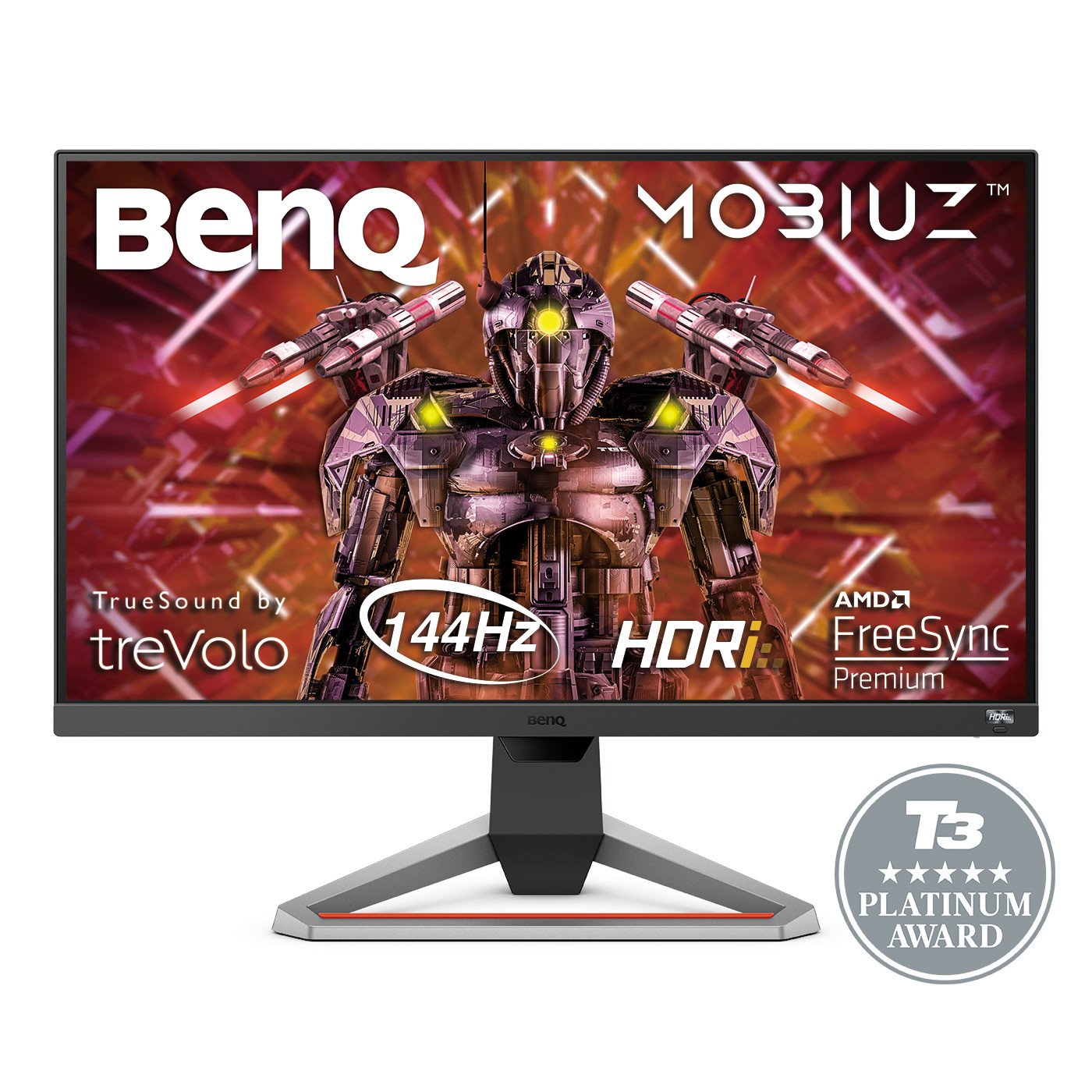Projectoren
Monitoren
Verlichting
Interactieve Displays | Signage
Werken & leren op afstand
Store
Quick guide to the features that make a gaming monitor great for your consoles and PC

While common wisdom has it that monitors are for PCs, reality shows us they’re equally great for console gaming. And with the arrival of the PS5 and Xbox Series X/S, there’s even more reason to enjoy your gaming on a monitor. To begin with, if you’re already a PC user and want to add a console to your desktop space, then a monitor for gaming is clearly a natural choice. Also, gaming monitors offer certain advantages for console users not found on large TVs. Pixel density, faster response, lower lag, and higher refresh rates all number among the boons offered by gaming monitors compared to TVs.
All of that applies to previous gen and current gen consoles, so even if you’re thinking of putting a PS4, Xbox One, or Switch on your desktop, a monitor for gaming is a superb investment. Monitors offer a close range viewing experience that reveals a lot more detail than what you’d get with a distantly-placed TV. And in general, consoles and PCs these days have similar needs when it comes to gaming monitors, so purchasing such a display represents good value thanks to multi-platform utility.
Let’s consider what you need to look for.
For 1080p gaming, you should go with 25” or 27” to maintain optimal pixel density and clarity. That would work best if you prefer high refresh rates or speedy frame rates. Consoles like the PS4 Pro, Xbox One X, and of course the PS5 and Xbox Series X/S all support 4K gaming, and for that we’d recommend a bigger screen. Going with a 32” format will provide excellent pixel density. When speaking of pixel density, we’re also considering viewing distance. Unlike TVs, monitors are meant for up close and personal usage, so resolution really matters. That’s in contrast to bigger displays. Think of a 65” TV viewed from 18 feet away. At those distances the benefits of 4K are actually quite minimal, and most people wouldn’t be able to tell the difference from 1080p, or regular full HD. By comparison, you’re only going to be seated a few feet away from your gaming monitor.
Keep in mind that the PS5 doesn’t officially support 1440p, so a 4K monitor would be a better investment. Or you can get a high speed, 144Hz 1080p monitor instead. Sony may add 1440p support in a future update. Conversely, Xbox Series X/S do support 1440p. The same situation extends to previous generation Sony and Microsoft consoles.
For console gaming, unlike PC, we have to insist on flat, 16:9 monitors. Ultra-wide, curved 21:9 monitors look very attractive, but their custom resolutions aren’t supported by any console at the time of this writing, and such support isn’t forthcoming.
Having said that, if the idea of a curved monitor really appeals to you, look for one that uses a standard resolution like 2560 x 1440. You won’t have the ultra-wide look, but also no issues with unsupported resolutions.

If you want to game in 4K, then a 60Hz monitor will do just fine, since in that resolution none of the existing consoles exceed 60 frames per second. However, should you prefer higher refresh rates for smoother gaming, then a premium 144Hz QHD monitor will serve you faithfully. Quite a few games already have 120Hz modes on PS5 and Xbox Series X/S, with more to come. All of them lower resolution to attain higher frame rates, so a 1440p monitor (aka QHD monitor) is perfect.
This depends on the kinds of games you like. First and third person shooters and any other reflex/twitch-based titles (like arcade racing games) benefit from 120Hz and above. Open world, first person exploration, simulators, and puzzle games often get by on 30Hz, and certainly play very well in 60Hz.
Applies mostly to Xbox consoles, which support VESA Adaptive Sync and HDMI Variable Refresh Rate, as well as AMD FreeSync. All of these fancy terms mean the console’s graphics processor and monitor know how to match their frame rates, by that avoiding unsightly screen tearing and additional lag-related issues. If you opt for an Xbox console, make certain the monitor you pick has FreeSync or Adaptive Sync support to get the most out of the experience.
Except for the Switch, all other consoles support mature high dynamic range. So regardless of which console you get, the monitor needs to have good HDR support. Look for DisplayHDR 400 and above, which tells you the monitor has been officially certified by VESA, the organization that sets most standards in the PC display industry.
HDR makes a noticeable difference in gaming, especially now that games ship with HDR data built in by the developers. Bright scenes appear distinct, colors have improved definition, and contrast is better utilized to give every scene more depth. Speaking of color, always choose monitors that provide 10-bit color depth. The panel itself can be 8-bit with frame rate control, that’s OK. Such panels showcase 10-bit color indistinguishable from native 10-bit panels, which are very rare and costly.
Every monitor maker has a different approach to optimizing HDR and color. BenQ, for example, has smart HDRi technology to modify high dynamic range output based on the content shown on the screen, so you automatically get the best HDR. Color Vibrance, Light Tuner, and Black Tuner likewise serve to optimize picture quality and keep important details from getting washed out or lost. Basic, budget monitors don’t have these features and therefore offer compromised, essentially non-modifiable output.
Remember, consoles also double as streaming and entertainment boxes. And all major streaming platforms, be it Netflix, Prime Video, Apple TV, Disney Plus, Hulu and so forth, well, all of them provide HDR-formatted content. This will be lost on a non-HDR display, so clearly a good HDR monitor rewards you in several ways beyond just gaming.
We just mentioned cheap monitors, and you should be wary of models that only have one HDMI and one DisplayPort. And if you see DVI mentioned anywhere, run. What you’re looking for is two HDMI 2.0 and one DisplayPort, with USB-C usually also included by good monitors. For consoles HDMI is the most important, and the only type of connection directly supported. With two HDMI ports you can connect an Xbox and a PlayStation to your monitor, with a PC via DisplayPort and a MacBook through USB-C. That’s a lot of connectivity for one monitor.
USB-C doubles as a convenient charging port for Xbox Series X/S and PS5 controllers, which moved from the previous generation’s micro USB to now-standard USB-C ports.
Audio on monitors often comes across as an afterthought, mostly thanks to generic monitors having no speakers or ones that sound like a used can of beans. There’s no reason for this to be the case, as quality audio doesn’t make gaming monitors hugely more expensive or anything. BenQ uses powerful treVolo audio suites to deliver impressive 2.1-channel sound. That’s two speakers and one subwoofer, hence the 2.1. You can always use headphones if you like (and we recommend that to avoid bothering others), but having good speakers is great. Especially since neither Xbox Series X/S nor PS5 have optical out, meaning it’s not as easy to get sound from them other than through HDMI.
These are the core things to look for when considering a gaming monitor as your display of choice for console. Tick all of these boxes and you’re pretty much set. There are additional things to keep in mind, like always go for an anti-glare, matte display rather than glossy, and try to get a monitor that uses blue light filters to reduce eye fatigue. BenQ calls that Eye-Care, a term that’s very self-explanatory. But in general, we’ve covered all the important bases, so now it’s up to you.
Based on feedback from competitive gamers and esports pros while leveraging BenQ’s legacy of high performance gaming monitors, we’ve created MOBIUZ. What is MOBIUZ? It’s defying conventional thinking and creating a new generation of gaming monitors that make every pixel count better.
Current MOBIUZ gaming monitors include the EX2710 and EX2510, or 27” and 25” respectively, as you probably guessed. We’re talking 144Hz with 1ms MPRT and FreeSync Premium for super responsive gameplay and sharp visuals on IPS panels that let colors come to life from wide viewing angles. Get close to the action and see every detail, helped along by real HDR. For gaming audio, MOBIUZ delivers the power of treVolo sound, with dual 2.5W speakers.
MOBIUZ monitors meet the demands of gamers that want fast and accurate response with a high degree of visual fidelity. Check out the MOBIUZ lineup.